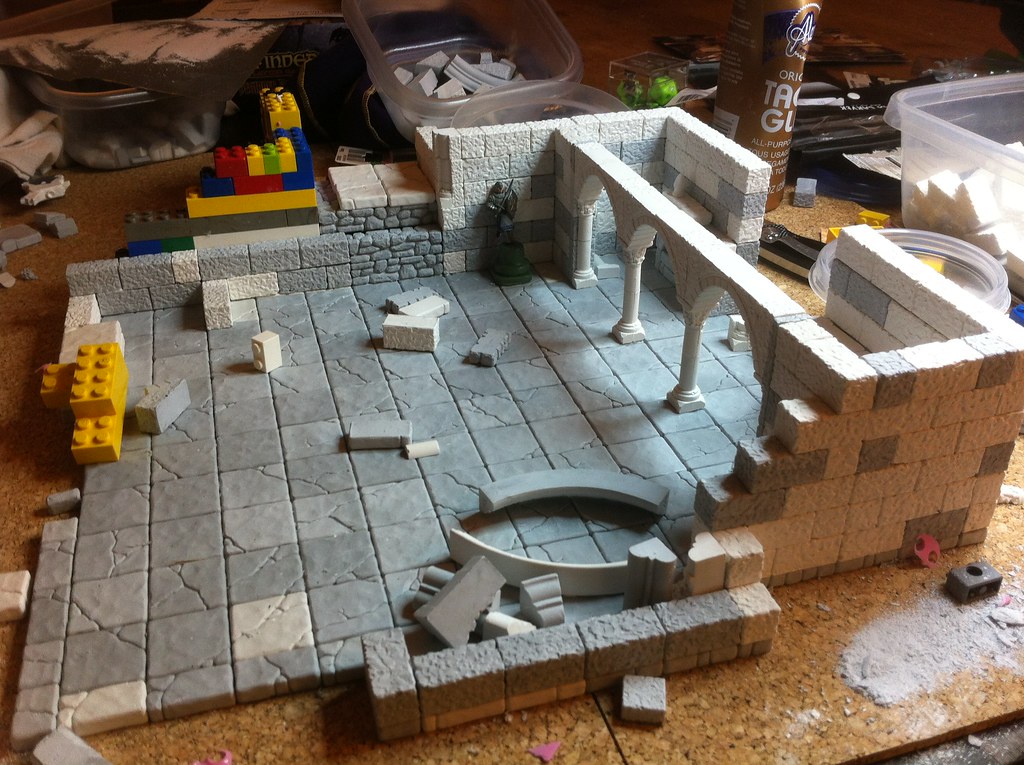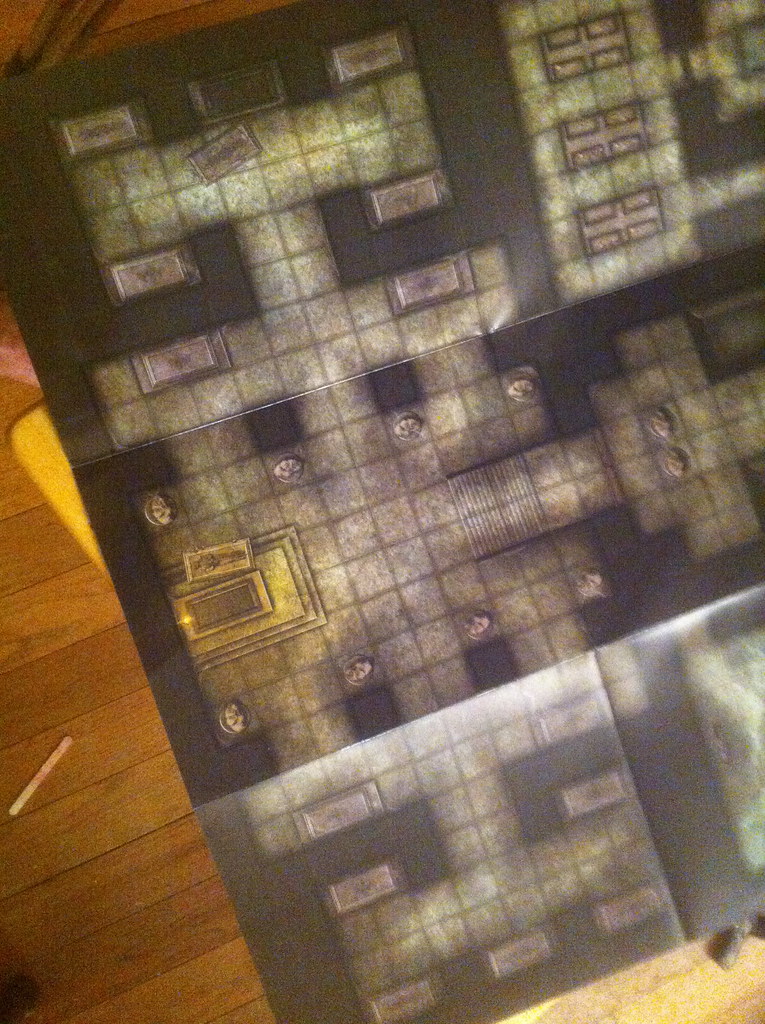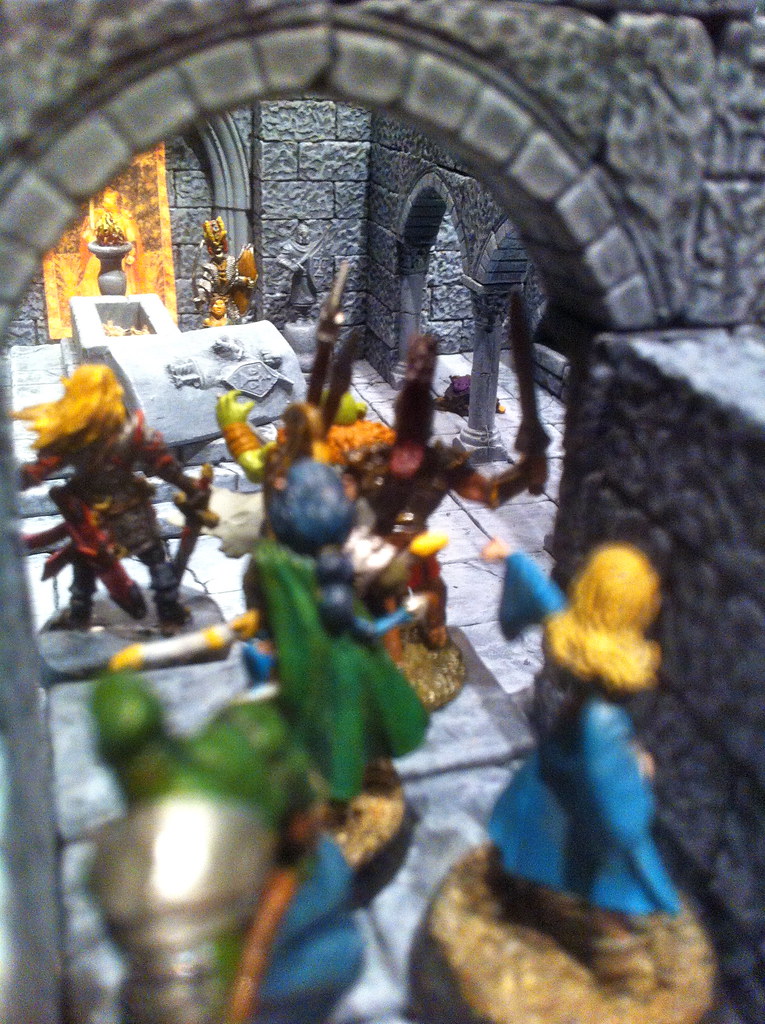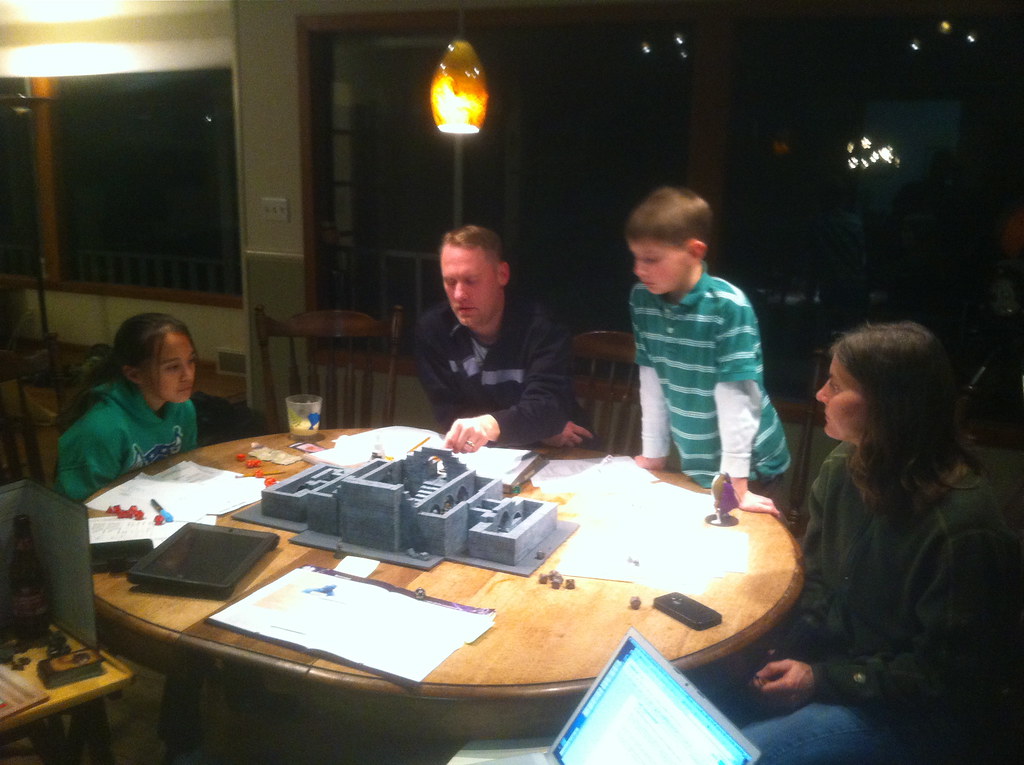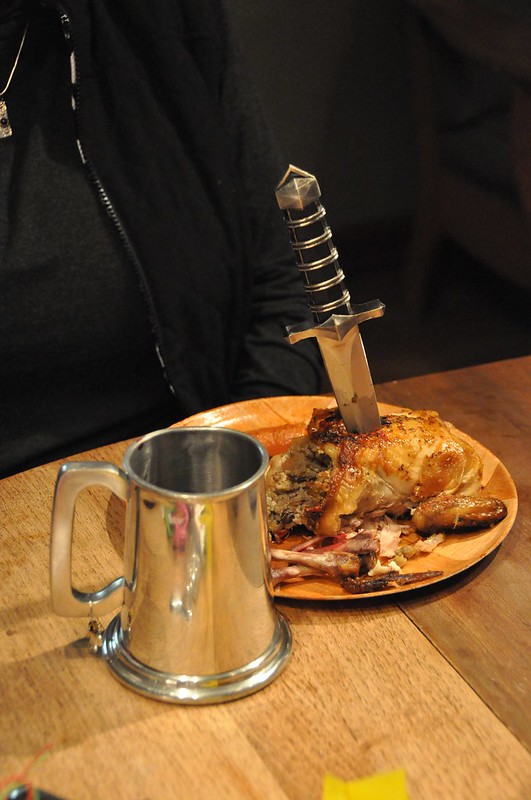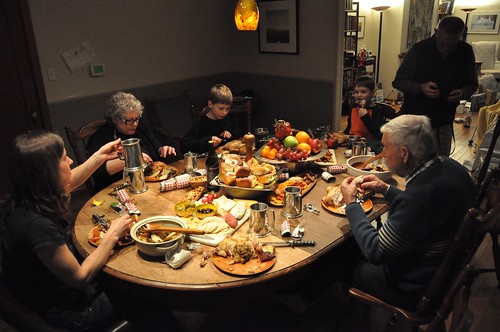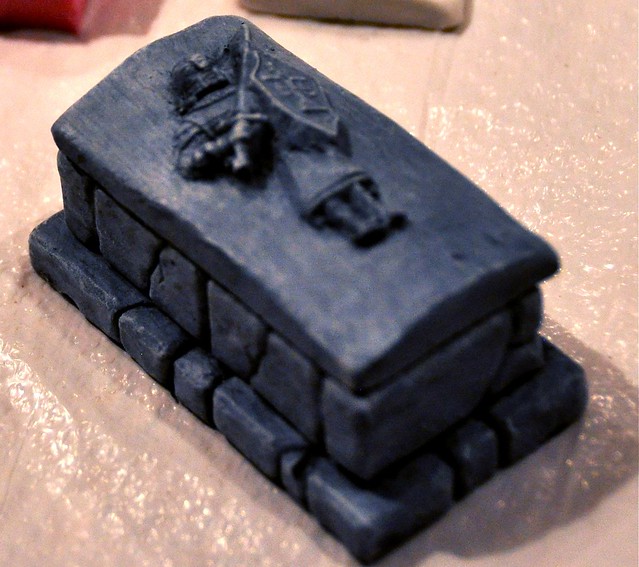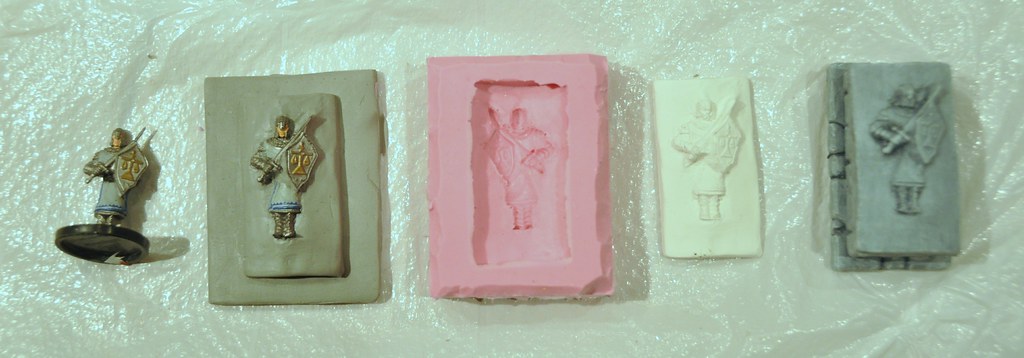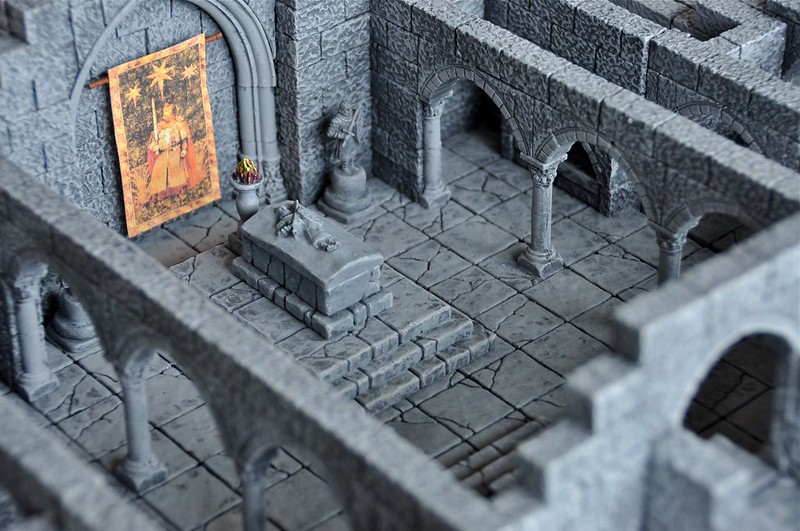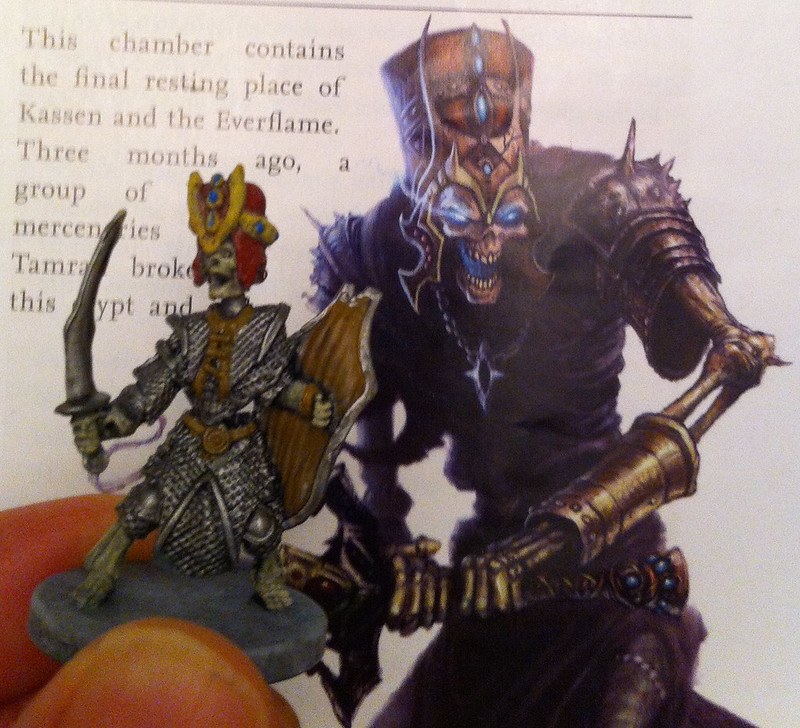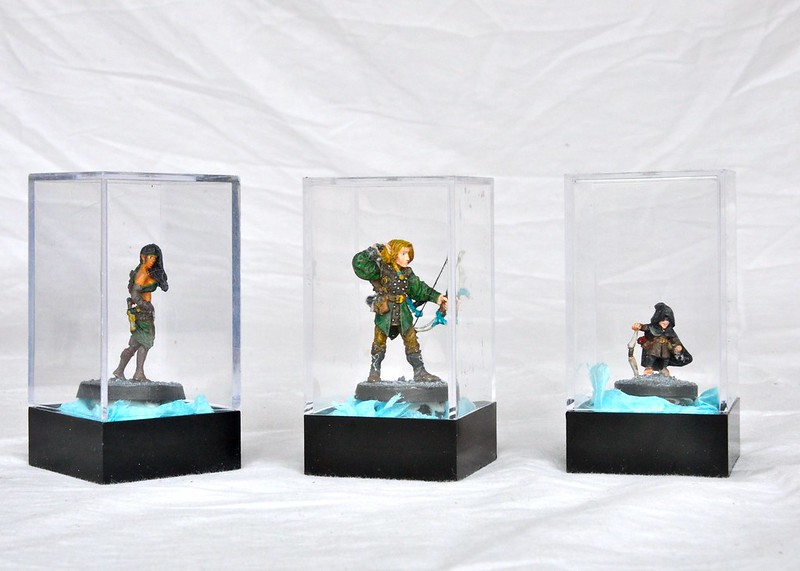.JPG)
Introducing my children to the wonders of role playing games and other marvels.
Sunday, June 2, 2013
Sunday, May 5, 2013
Figure Mods
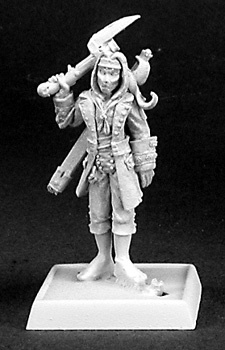
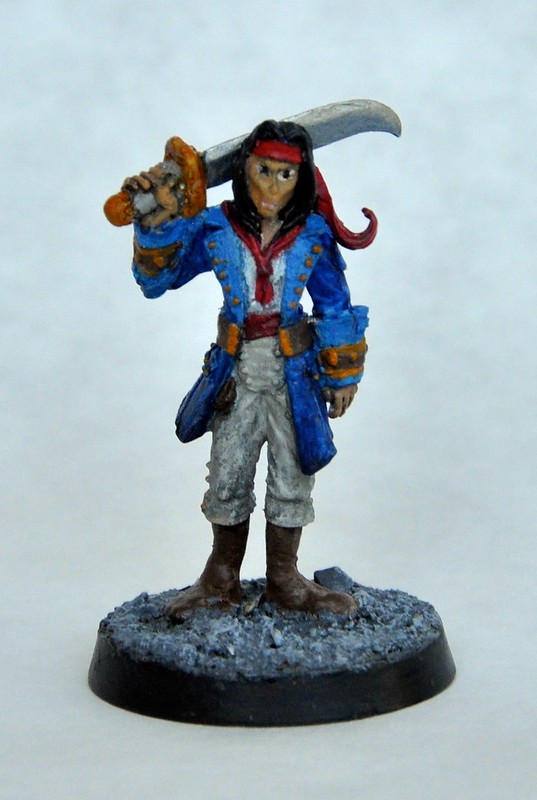 Even though we are using virtual table top software, as a group we still like miniatures so the extent of our use of the software is to project high quality maps with dynamic lighting. We all get by with our painting, and I am willing to put quite a bit of time into the player models. I prefer that the figures pretty closely match the character. For instance in the Carrion Crown adventure path being run by Jerrod I am a cutlass wielding magus that is a member of the Jenevier's crew. So, sailor-like, with cutlass. I found a good Reaper Mini, but he was holding a musket, so I changed that. I snipped off the pistol you can see in the right image, and added the front of a cutlass that I also ordered from Reaper. Sadly we're playing with Cthulhu-esque insanity rules and this character will be insane soon.
Even though we are using virtual table top software, as a group we still like miniatures so the extent of our use of the software is to project high quality maps with dynamic lighting. We all get by with our painting, and I am willing to put quite a bit of time into the player models. I prefer that the figures pretty closely match the character. For instance in the Carrion Crown adventure path being run by Jerrod I am a cutlass wielding magus that is a member of the Jenevier's crew. So, sailor-like, with cutlass. I found a good Reaper Mini, but he was holding a musket, so I changed that. I snipped off the pistol you can see in the right image, and added the front of a cutlass that I also ordered from Reaper. Sadly we're playing with Cthulhu-esque insanity rules and this character will be insane soon. The second modification we needed for Carrion Crown was my wife's cleric. I love playing with people that don't know the rules because their characters are completely story-driven or "this is interesting"-driven. She is a cleric who worships Jazirian, the god of the Couatl, "a long, feathered serpent with a pair of rainbow-feathered wings that allow it to fly." (Wikipedia, 2013).
Because of the rainbow colored wings she found an image of a woman with
rainbow colored hair, and the look of her character was formed.
The second modification we needed for Carrion Crown was my wife's cleric. I love playing with people that don't know the rules because their characters are completely story-driven or "this is interesting"-driven. She is a cleric who worships Jazirian, the god of the Couatl, "a long, feathered serpent with a pair of rainbow-feathered wings that allow it to fly." (Wikipedia, 2013).
Because of the rainbow colored wings she found an image of a woman with
rainbow colored hair, and the look of her character was formed. 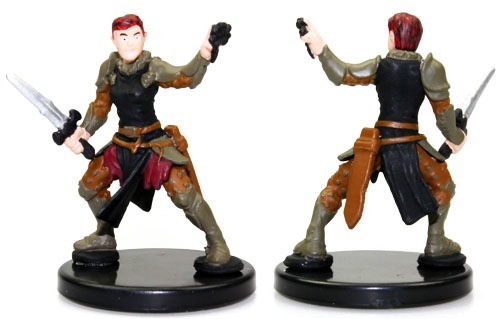
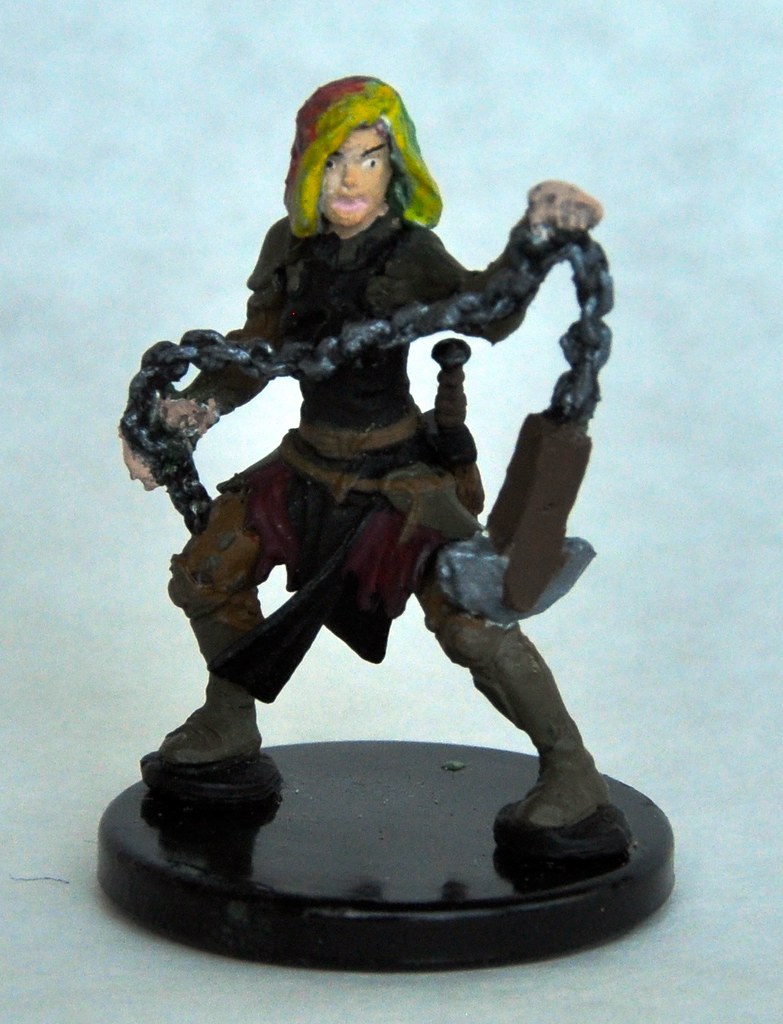 Based on some of my knowledge of Pathfinder, and the usefulness of attacks-of-opportunity as a focus for clerics we decided her character would use a "Flying Blade". An exotic gladiator style weapon consisting of a crescent shaped blade at the end of a 10 foot chain. In our first session we quickly found a figure for her. The WizKid's "Evil Cleric" was close. Short, bright hair with studded leather. Good enough. Finally, after a few weeks of play I modified the WizKids figure. Using Green Stuff I modeled and painted some hair (BIG improvement!). I ordered some chains from Reaper (and am just noticing the great crescent shaped blades). I modeled a blade using Green Stuff, snipped off the Evil Cleric's holy symbol and blade and worked it all together. Last I added a hilt for the sword that should be in the scabbard. (I have some Games Workshop sets and you end up with tons of extra weapons.
Based on some of my knowledge of Pathfinder, and the usefulness of attacks-of-opportunity as a focus for clerics we decided her character would use a "Flying Blade". An exotic gladiator style weapon consisting of a crescent shaped blade at the end of a 10 foot chain. In our first session we quickly found a figure for her. The WizKid's "Evil Cleric" was close. Short, bright hair with studded leather. Good enough. Finally, after a few weeks of play I modified the WizKids figure. Using Green Stuff I modeled and painted some hair (BIG improvement!). I ordered some chains from Reaper (and am just noticing the great crescent shaped blades). I modeled a blade using Green Stuff, snipped off the Evil Cleric's holy symbol and blade and worked it all together. Last I added a hilt for the sword that should be in the scabbard. (I have some Games Workshop sets and you end up with tons of extra weapons.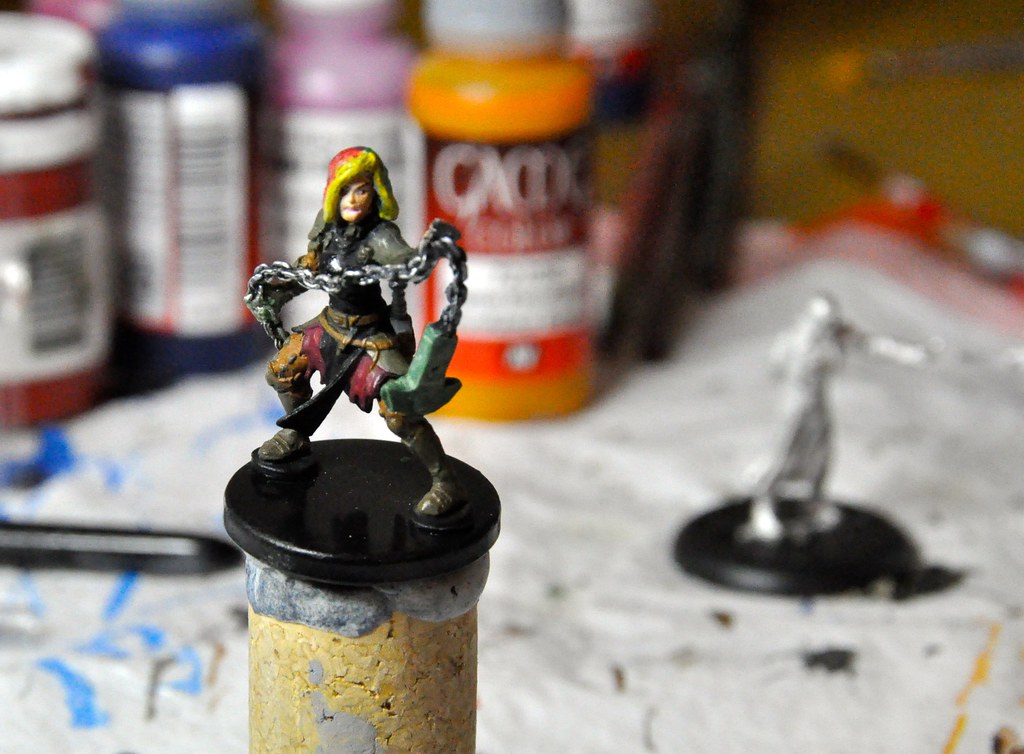
You can do a lot with a little Green Stuff and very little skill. Again though, I have the greatest respect for skilled modelers. I can barely make a simple ... anything. While I will likely never have any skill at modeling I am hoping to one day make my own figure. In a later post I will show some of the figures my kids and I have attempted.
Sunday, April 21, 2013
Future ... I am in you ...
 We are beginning a couple of new campaigns here. My cousin is running a horror based campaign, Carrion Crown, and his daughter is going to run Serpant's Skull, a jungle crawl. A few things came together at the last minute prior to the horror of Carrion Crown starting that allowed us to try digital maps with interactive lighting.
We are beginning a couple of new campaigns here. My cousin is running a horror based campaign, Carrion Crown, and his daughter is going to run Serpant's Skull, a jungle crawl. A few things came together at the last minute prior to the horror of Carrion Crown starting that allowed us to try digital maps with interactive lighting. This allows us to display the professionally rendered maps found in the modules. It's always sad that the game master gets to see the professional maps, but the players just get to see the DM's chicken scratch reproductions. While you can create awesome 3D representations such as in our Everflame game these take an extreme amount of time. While I intend to still make models like from our Everflame game, projecting the provided maps is quick and easy. Paizo even provides PDF interactive maps that allow you to turn off the room labeling as well as activate a "player view" that conceals secret doors and the like.
.JPG) Using the provided maps you can now easily project them, but you need to be able to cover what the players can't see. There are many virtual table top programs that allow this "fog of war" behavior but what I really wanted was "dynamic lighting". Dynamic lighting allows you to place a token on the map as a light source, and then that light source will reveal only the parts of the map that you could see based off of how far you defined the light to shine, and what walls are in the way. With a little bit of work on a map including the adding of walls and doors you've got a whole new layer to the game.
Using the provided maps you can now easily project them, but you need to be able to cover what the players can't see. There are many virtual table top programs that allow this "fog of war" behavior but what I really wanted was "dynamic lighting". Dynamic lighting allows you to place a token on the map as a light source, and then that light source will reveal only the parts of the map that you could see based off of how far you defined the light to shine, and what walls are in the way. With a little bit of work on a map including the adding of walls and doors you've got a whole new layer to the game.A few of the existing virtual table tops have this functionality, but I settled on Roll20 because one, it was the easiest to figure out, and two I had an account already, with full privileges because I contributed to the Kickstarter for TableTop Forge which later merged with Roll20.
Now, we can display high quaility maps and show exactly what our characters can see at any given time. The group can see where shadows are (and thus where maybe you could hide), and instead of wasting time drawing maps that look horrible, we just display them. Like I said, it's a whole new layer to the game. Currently we are projecting from above, but we are also considering embedding a 42" LED in a table, or doing rear projections.
Basically, at this point, it's all gravy.
Sunday, January 13, 2013
The Build - Crypt of the Everflame
Here is a Flikr photo set with images from the build of the Crypt of the Everflame. I really have no estimate of the time it took to do as I did an hour here, a few here, cast bricks while doing other things, etc. It was a three or more months of calendar time though, but I went weeks without working on it.
I tried to stay as true to the provided map as possible while making alterations necessary for working with the Hirst Arts materials. For instance you can see the pillars in the map are 5' x 5' while the Hirst Arts pillars are smaller, thus placement was different. Also, originally I did not know I was going to make sarcophagus lids so I used insets in the walls at first. All in all I think it ended up being pretty close to the original while utilizing some of the cool things that could be done with Hirst Arts.
This was my first such build. As stated in an earlier post, I was introduced to this technique during two sessions at PaizoCon 2012 presented by Sean Reynolds. One was using foam for terrain making and the other was on casting castle and dungeon bits using Hirst Arts molds. I highly recommend the Reynolds sessions as a great introduction to both techniques, and recommend Hirst Arts. Hirst makes awesome molds that can be used for specific builds, or for making Dwarven Forge type reusable pieces.
Here is a list of some of the materials I used in this build:
I tried to stay as true to the provided map as possible while making alterations necessary for working with the Hirst Arts materials. For instance you can see the pillars in the map are 5' x 5' while the Hirst Arts pillars are smaller, thus placement was different. Also, originally I did not know I was going to make sarcophagus lids so I used insets in the walls at first. All in all I think it ended up being pretty close to the original while utilizing some of the cool things that could be done with Hirst Arts.
This was my first such build. As stated in an earlier post, I was introduced to this technique during two sessions at PaizoCon 2012 presented by Sean Reynolds. One was using foam for terrain making and the other was on casting castle and dungeon bits using Hirst Arts molds. I highly recommend the Reynolds sessions as a great introduction to both techniques, and recommend Hirst Arts. Hirst makes awesome molds that can be used for specific builds, or for making Dwarven Forge type reusable pieces.
Here is a list of some of the materials I used in this build:
- Hirst Arts - Basic Block - Mold #40
- Hirst Arts - Gothic Additional Accessories - Mold #44
- Hirst Arts - Gothic Dungeon Builder - Mold #45
- Hirst Arts - Fieldstone Wall Mold #70
- Hirst Arts - Cracked Floor Tiles - Mold #203
- Hirst Arts tutorial on mold making
- Merlin's Magic Hobby Stone - White (I bought the 50# box)
- Mold Max 30 Silicone (for making my own molds)
- Black and White latex house paint and Hirst Arts Painting Instructions
- Duncan 120105 Aleenes Original in. Tacky in. Glue-2 Ounce (Google Affiliate Ad)
- Crypt of the Everflame Module and Map
Labels:
DnD,
Miniatures,
Paizo,
Pathfinder,
RPG,
Terrain,
Wargaming
Crypt of the Everflame Game Play
When finally had the chance to use my Hirst Arts crypt in game play. I made some alterations to the encounter to allow us to spend a bit more time with it. Instead of the written four skellies supporting Asar I have him fifteen. Some of these were D&D fourth edition-esque "minions". I did not want to TPK the party, but I did want to extend the number of rounds they were there. Not all fifteen were exposed at first either, so this lessened the impact. In addition one skeleton had a trick-shot bow that he used to disarm, trip, etc. Again, not causing damage, just delaying players. Another skeleton used an enhanced bashing shield (written into the encounter) to bull rush with.
Asar at first held the hostage as a shield to prevent ranged attacks. I also gave him a "Push" spell ability to push back immediate threats. Last, I allowed Asar to raise four corpses (the bandits) as minion style zombies. When that happened the collapse feature of my crypt archway was triggered, hampering players in the area.
Doing all this took the encounter towards, but not TOO close to a TPK. We had two members down at one point, and let us play for over two hours. A good time was had by all. Other modifications to this encounter included an interesting magic item for each player. Again, this module was the first RPG experience for a couple of the members, and a early experience for a couple others, so I wanted there to be some good loot as a reward for them.
Check out the Flikr - Photo Set.
Asar at first held the hostage as a shield to prevent ranged attacks. I also gave him a "Push" spell ability to push back immediate threats. Last, I allowed Asar to raise four corpses (the bandits) as minion style zombies. When that happened the collapse feature of my crypt archway was triggered, hampering players in the area.
Doing all this took the encounter towards, but not TOO close to a TPK. We had two members down at one point, and let us play for over two hours. A good time was had by all. Other modifications to this encounter included an interesting magic item for each player. Again, this module was the first RPG experience for a couple of the members, and a early experience for a couple others, so I wanted there to be some good loot as a reward for them.
Labels:
DnD,
Miniatures,
Paizo,
Pathfinder,
RPG,
Terrain,
Wargaming
Tuesday, January 8, 2013
Back to the Inn
Ever since we had kids my family has not left home on Christmas. We don't travel to the various parents (all local), we make them come to us. In return we usually do dinner for a couple sets of them. (We have more than our share)
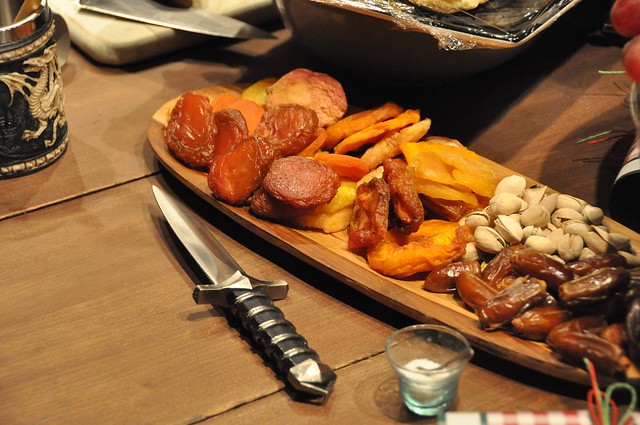 For some reason my wife and I decide that this year our Christmas dinner should be a medieval feast. I think the thought process was, "let's do game hens ... hey, what about buying tankards and daggers and calling it a medieval feast!" We're like that. Given the bounty of good fresh and dried fruits, vegetables, meats, drinks and such it was probably more of a fantasy feast that an adventuring party may order up with some of the haul from the latest dungeon delve.
For some reason my wife and I decide that this year our Christmas dinner should be a medieval feast. I think the thought process was, "let's do game hens ... hey, what about buying tankards and daggers and calling it a medieval feast!" We're like that. Given the bounty of good fresh and dried fruits, vegetables, meats, drinks and such it was probably more of a fantasy feast that an adventuring party may order up with some of the haul from the latest dungeon delve.
I found some very cheap daggers (what I found were actually $1.75 ... sadly I had to pay shipping on EACH one. Still cheap), a set of wooden plates, and I scored a great eBay purchase on some glass bottomed pewter tankards. Add piles of food and a carcass each and it was probably the best Christmas dinner since the pagans were converted.
The best part was that we didn't even warn anyone. When it was time to eat we just sat everyone down ... "Here's your dagger ... throw me a sweet roll!" I am looking forward to incorporating this into a gaming session.
 For some reason my wife and I decide that this year our Christmas dinner should be a medieval feast. I think the thought process was, "let's do game hens ... hey, what about buying tankards and daggers and calling it a medieval feast!" We're like that. Given the bounty of good fresh and dried fruits, vegetables, meats, drinks and such it was probably more of a fantasy feast that an adventuring party may order up with some of the haul from the latest dungeon delve.
For some reason my wife and I decide that this year our Christmas dinner should be a medieval feast. I think the thought process was, "let's do game hens ... hey, what about buying tankards and daggers and calling it a medieval feast!" We're like that. Given the bounty of good fresh and dried fruits, vegetables, meats, drinks and such it was probably more of a fantasy feast that an adventuring party may order up with some of the haul from the latest dungeon delve.I found some very cheap daggers (what I found were actually $1.75 ... sadly I had to pay shipping on EACH one. Still cheap), a set of wooden plates, and I scored a great eBay purchase on some glass bottomed pewter tankards. Add piles of food and a carcass each and it was probably the best Christmas dinner since the pagans were converted.
The best part was that we didn't even warn anyone. When it was time to eat we just sat everyone down ... "Here's your dagger ... throw me a sweet roll!" I am looking forward to incorporating this into a gaming session.
Creating a Sarcophagus
In an earlier post I showed you Kassen's Tomb that I built using Hirst Arts molds and my knowledge acquired from a brief introduction to terrain building from Sean Reynolds at PaizoCon 2012. In addition to the Hirst molds, I created my own mold for the sarcophagus lid and a base for the statues. The Hirst Arts site has links to mold making instructions as well as materials one needs to do this. I also watched various videos on mold making that mainly taught me the usefulness of legos in this process. My material list included.
- Hirst Arts - Cracked Floor Tiles - Mold #203
- Hirst Arts tutorial on mold making
- Merlin's Magic Hobby Stone - White (I bought the 50# box)
- Mold Max 30 Silicone
- Merchant Guard #12 Desert of Desolation mini
- Black and White latex house paint and Hirst Arts Painting Instructions
Labels:
DnD,
Miniatures,
Paizo,
Pathfinder,
RPG,
Terrain,
Wargaming
Monday, January 7, 2013
Crypt of the Everflame - Kassen's Tomb
A few months ago I started a campaign to introduce my cousin's kids (I guess I could just say my once-removed cousin's) to D&D ... or actually Pathfinder (We all say D&D. My habit has even trained my children and these children to call all fantasy RPG's D&D ... it's like Kleenex or Xerox ... but more fun.)
I started the campaign shortly after attending PaizoCon 2012. I had a great time at PaizoCon and have signed up my oldest son (10) and myself for this year's festivities. In any case I was fortunate enough to "win" lotteries to attend two sessions presented by Sean Reynolds. One was using foam for terrain making and the other was on casting castle and dungeon bits using Hirst Arts molds. I highly recommend the Reynolds sessions as a great introduction to both techniques, and recommend Hirst Arts. Hirst makes awesome molds that can be used for specific builds, or for making Dwarven Forge type reusable pieces.
Given my new knowledge, and the fact that I was indoctrinating four new players into the realm of RPGs (7-12 yrs old) as well as my wife, and re-introducing my cousin (we had not played for some 20 years), I thought I would end the Crypt of the Everflame with a bang by making the crypt using Hirst Arts product. The project turned out great for my first time out. You can see more pictures of the tomb in this Flikr photo set.
The final encounter was delayed a good month while I finished my first project of this type. With Mr. Reynold's kick start introduction, and the directions on the Hirst Arts site I was not just able to use the molds, but also to sculpt and create a mold of my own for the sarcophagus lid and statue bases, as well as do some minor miniatures sculpting to give Asar his silly hat. (Just when do warriors that become Skeletal Champions get issued that stupid hat ... I would be all pissy and kill everyone too if I had to wear that abomination.) I used the hatless D&D: Lord of Madness - Skeleton as the base for Asar. I see of course that paizo is doing an actual skeletal champion in it's Shattered Star release of miniatures.
In a later blog I will detail the build process and the gaming session, as well as what I did to extend the encounter to make the umpteen dozen hours of building somewhat more worth it! With that in mind, I've also devised a reason for them to come back here to use this again.
In any case I strongly recommend trying this out for yourself. It's rewarding, fun, makes for great play, and is not really that expensive or difficult to do.
I started the campaign shortly after attending PaizoCon 2012. I had a great time at PaizoCon and have signed up my oldest son (10) and myself for this year's festivities. In any case I was fortunate enough to "win" lotteries to attend two sessions presented by Sean Reynolds. One was using foam for terrain making and the other was on casting castle and dungeon bits using Hirst Arts molds. I highly recommend the Reynolds sessions as a great introduction to both techniques, and recommend Hirst Arts. Hirst makes awesome molds that can be used for specific builds, or for making Dwarven Forge type reusable pieces.
Given my new knowledge, and the fact that I was indoctrinating four new players into the realm of RPGs (7-12 yrs old) as well as my wife, and re-introducing my cousin (we had not played for some 20 years), I thought I would end the Crypt of the Everflame with a bang by making the crypt using Hirst Arts product. The project turned out great for my first time out. You can see more pictures of the tomb in this Flikr photo set.
The final encounter was delayed a good month while I finished my first project of this type. With Mr. Reynold's kick start introduction, and the directions on the Hirst Arts site I was not just able to use the molds, but also to sculpt and create a mold of my own for the sarcophagus lid and statue bases, as well as do some minor miniatures sculpting to give Asar his silly hat. (Just when do warriors that become Skeletal Champions get issued that stupid hat ... I would be all pissy and kill everyone too if I had to wear that abomination.) I used the hatless D&D: Lord of Madness - Skeleton as the base for Asar. I see of course that paizo is doing an actual skeletal champion in it's Shattered Star release of miniatures.
In a later blog I will detail the build process and the gaming session, as well as what I did to extend the encounter to make the umpteen dozen hours of building somewhat more worth it! With that in mind, I've also devised a reason for them to come back here to use this again.
In any case I strongly recommend trying this out for yourself. It's rewarding, fun, makes for great play, and is not really that expensive or difficult to do.
Labels:
DnD,
Miniatures,
Paizo,
Pathfinder,
RPG,
Terrain,
Wargaming
Sunday, January 6, 2013
Good Use for Chessex Dice Containers
So here is a good use for Chessex (and other) dice containers ... miniatures gift boxes! We were trying to go a little cheaper this Christmas so one of the things I gave my kids and wife were custom painted figures by me. In trying to find a way to nicely display the figures I stumbled across some Chessex dice containers (of which we have many). I used a 4x1 square lego puttied into the black base. I used the same reuseable and non-permanent poster putty to hold the figure onto the lego. I put blue decorative tissue paper around the base and sealed them up. They stay in place even when the packages were wrapped and banged around a little.
While I'm on the topic I will present some of my recent paints. It's been years, perhaps 25 years, since I painted mini's. Back in my day I basically did it all through trial and error. No YouTube tutorials, I didn't talk at the stores (American Eagles in Seattle) about technique, and the couple other people that were also painting did not venture out of the circle we were all a part of. So, when my kids encouraged the re-introduction of D&D, and we evolved beyond Lego figures I started painting again ... and now I have YouTube. YouTube can teach you anything. Here is a Flikr Photo Set - "Figures", with some of my recent paints. I would say that these fall somewhere in quality between "better than your standard pre-painted plastic miniature" and "well below the pro" jobs. I am quite pleased with my current output however, even though as GirlPainting on YouTube would say, they are not a very "high standard".
While I'm on the topic I will present some of my recent paints. It's been years, perhaps 25 years, since I painted mini's. Back in my day I basically did it all through trial and error. No YouTube tutorials, I didn't talk at the stores (American Eagles in Seattle) about technique, and the couple other people that were also painting did not venture out of the circle we were all a part of. So, when my kids encouraged the re-introduction of D&D, and we evolved beyond Lego figures I started painting again ... and now I have YouTube. YouTube can teach you anything. Here is a Flikr Photo Set - "Figures", with some of my recent paints. I would say that these fall somewhere in quality between "better than your standard pre-painted plastic miniature" and "well below the pro" jobs. I am quite pleased with my current output however, even though as GirlPainting on YouTube would say, they are not a very "high standard".
Labels:
DnD,
Miniatures,
Paizo,
Pathfinder,
RPG,
Terrain,
Wargaming
Subscribe to:
Posts (Atom)
